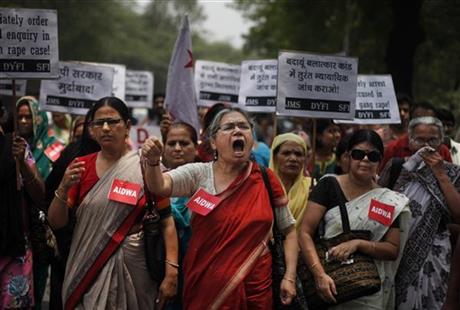LUCKNOW, India (AP) — The two teenage girl cousins had walked out together at night, as they did every night, into the wild bamboo fields 10 or 15 minutes from their mud-and-straw huts to relieve themselves. Like millions of families across India, they had no toilet at home.

In the dark, they were attacked, gang-raped and killed. The assailants then hung their bodies from a mango tree in their village.
Beyond highlighting the rampant sexual violence in India, last week’s horrific crime is drawing attention to a glaring problem across the country that threatens women’s safety: the lack of toilets.
U.N. figures show of India’s 1.2 billion people, 665 million — mostly those in the countryside — don’t have access to a private toilet or latrine, something taken for granted in developed nations. Some villages have public bathrooms, but many women avoid using them because they are usually in a state of disrepair and because men often hang around and harass the women.
Around 65 percent of the rural population in India defecates in the open and women and girls are expected to go out at night. This does not only threaten their dignity, but their safety as well, UNICEF representative Louis-Georges Arsenault said in a statement.
Bindeshwar Pathak, founder of the Sulabh Sanitation and Social Reform Movement — a group that helps build low-cost toilets — estimates the country needs about 120 million more latrines. Since the attack, his group has decided to construct toilets in 108 houses in the girls’ village of Katra Sadatganj in the northern, densely populated state of Uttar Pradesh.
Indian women aren’t alone in their vulnerability as they use either unhygienic public latrines or visit the fields to relieve themselves. From villages in Nepal to the urban slums of Cape Town, South Africa, women say that lack of safe access to toilets often puts them at risk of sexual violence and harassment.
The 14- and 15-year-old cousins were dalits, at the bottom of Hinduism’s caste hierarchy, making them even more vulnerable to attacks from men, particularly of higher castes.
They did not go out alone, but there were just two of them. Women generally gather in groups to go to the fields to relieve themselves. To avoid embarrassment they usually go at dawn and late at night. Male family members usually don’t go with the women since modesty is a major consideration.
After the girls had left, an uncle, Baburam, went out to make sure the cows hadn’t trampled his patch of mint, The Indian Express newspaper reported. He heard some screams and shone his flashlight toward four men dragging the girls away across the fields, he told the newspaper. They threatened him with a gun.
I was scared and I fled, he said. I now wish I hadn’t.
The state’s top police official made a clear link between rape and the lack of toilets.
More than 60 percent of the rapes in the state occur when the victims step out to relieve themselves because they do not have toilets at their homes, Ashish Gupta told reporters in the state capital, Lucknow. It is difficult to give protection to every woman who goes out in the open to relieve herself.
A lack of toilets is also a problem in urban slums, but the dangers are greater in rural areas because girls and women must go out into the fields, where they are more vulnerable.
The evenings are really scary. The young men, sometimes drunk, pass indecent remarks and we can do nothing, said Sarita Kuswaha, a 50-year-old mother of two. She was once attacked by a man when she was out in the fields in her village near Milkipur, a small town in Uttar Pradesh.
I told my mother-in-law, but she asked me to keep quiet because that person was a relative of the village head, she said.
In April, two women and two teenagers were raped in some fields in the northern state of Haryana. Those women were also dalits and their attackers were Jats, a superior caste.
New Prime Minister Narendra Modi and his Hindu nationalist Bharatiya Janata Party promised toilets before temples in their election manifesto. The former Congress party-led government also promised to deliver sanitation services to villages and urban slums, but those projects lagged due to corruption, misuse of finances and a lack of political will.
In Uttar Pradesh, a massive sanitation project was launched in collaboration with the federal government in 2002 to build toilets, yet the most recent data from 2011 show that only 22 percent of the state’s households have them.
This data clearly proves that the public money has been flushed away in the toilets, said Alok Ranjan, a senior government official.
While the village waits for Pathak’s group to build toilets, a local women’s rights organization issued an advisory for women. Their primary suggestion: move in big groups.
___
Associated Press writer Muneeza Naqvi in New Delhi contributed to this report.





